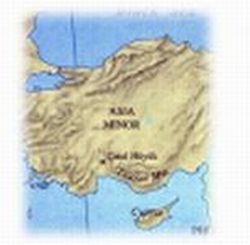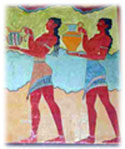[wp_ad_camp_1]
Ice Age Weasels
 Seems like weasels have been around for quite a while.
Seems like weasels have been around for quite a while.
There are a number of references on the Internet of weasels being around in the late Eocene and earliest Oligocene periods.
And many thousands of years ago weasels, as well as other animals including a saber-toothed cat, got sucked into the La Brea Tar Pits and were immortalized forever as near-perfect specimens in the asphalt.
What a perfectly revolting way to get preserved!
The Neolithic Weasel
Çatalhöyük is a Neolithic site in central Turkey which has been dated to around 7000-6000 BC.
 Archaeologists discovered paintings on the walls on the houses of Çatalhöyük showing mainly hunting scenes and plaster wall reliefs. The strangest pieces found were plaster breasts that stuck out from many walls, some of which had burst open to reveal the skulls of vultures or weasels.
Archaeologists discovered paintings on the walls on the houses of Çatalhöyük showing mainly hunting scenes and plaster wall reliefs. The strangest pieces found were plaster breasts that stuck out from many walls, some of which had burst open to reveal the skulls of vultures or weasels.
During excavations of the houses, the archaeologists came across the skeleton of an adult female who was buried in the centre of the room with a complete weasel skeleton. They also found a weasel-type penis bone, which was buried together with an adult male in another part of the area several years later.
I wonder if we can assume that these discoveries show the first attachment of man to mustelids? Perhaps the weasels kept Çatalhöyük free of mice and other vermin more than 8000 years ago.
The Minoan Civilization
 Animals have long helped humans to predict natural disasters and the first documented case was in 2000 BC, when an ancient manuscript noted that weasels suddenly disappeared from their usual habitats in Crete shortly before a very powerful earthquake rocked the island.
Animals have long helped humans to predict natural disasters and the first documented case was in 2000 BC, when an ancient manuscript noted that weasels suddenly disappeared from their usual habitats in Crete shortly before a very powerful earthquake rocked the island.
And thus spake Zarathustra .. re the weasel
Zarathustra (aka Zoroaster)
 Zarathustra was a prophet in Persia way back in antiquity and his name meant “owner of feeble camels”, since “Zarata” = feeble, and “ustra” = camels.
Zarathustra was a prophet in Persia way back in antiquity and his name meant “owner of feeble camels”, since “Zarata” = feeble, and “ustra” = camels.
Zoroastrianism was conceived probably before 600 BC, and we find that the weasel is mentioned in The Dabestan-e Madaheb (School of religious doctrines) Sect. XIV of the belief of the Zerdushtian.
The Sixty-First Gate: Slay not the Hujjah or weasel, for it is the destroyer of serpents.
I’m really glad his name wasn’t “Zarathujjah”, as that would have meant feeble weasels and we couldn’t have that, could we? 
A Biblical Reference [c 450 BC]
 Those of you who’ve read the King James Version of the Bible will be aware that in Leviticus, chapter 11, verse 29, there is the following references to the weasel:
Those of you who’ve read the King James Version of the Bible will be aware that in Leviticus, chapter 11, verse 29, there is the following references to the weasel:
11:29 These also shall be unclean unto you among the creeping things that creep upon the earth; the weasel, and the mouse, and the tortoise after his kind,
Leviticus is the 3rd book of the Pentateuch, or Torah, and is a collection of laws regulating activities such as sacrificial offerings, installation of priests, cultic purity (including dietary laws) and so forth.
Since it has been dated to around 450 BC, I guess that is pretty good proof that the weasel, at least, was known to the ancient Israelites all those many years ago. Was the ferret also known to them, I wonder, or was that just ye olde English translation?
As other versions of the Bible use other animals such as the rat, the mole, the gecko and the shrew instead of our two magnificent mustelids, it’d be great to find out what the original texts had listed in those verses.
Well, I’ve scoured the Internet and the only thing I could find was a list of 613 commandments in the Torah, showing what is required, permitted and forbidden by God.
In the Parshah VaYikra (literal translation: ‘section Leviticus’) 11:29 there was the commandment — “The ritual uncleanness of eight low crawling creatures”.
That’s it! No description of those 8 low crawling creatures. I wonder why the King James Version chose the weasel as 1 of the 8 low crawling creatures.
And I mean, hey, since when do weasels CRAWL, hmmm? Bounce, pronk, scamper, trot, yes – but crawl? I don’t think so!
[wp_ad_camp_3]
